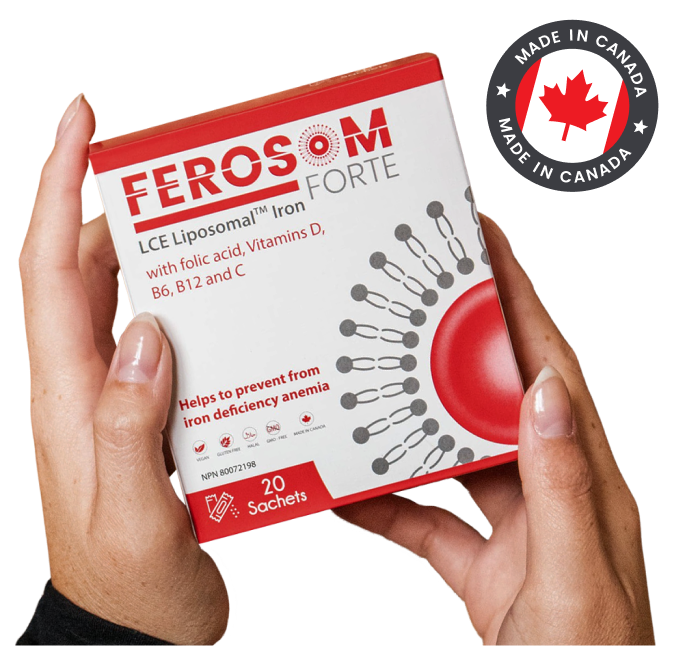

Iron deficiency anemia is up to 18% more prevalent in women than men. That’s a big difference—and it means women need more iron day-to-day.
From periods to pregnancy, let’s explore the reasons why women are more prone to anemia and what you can do to avoid iron deficiency for the long run.
What is anemia?
Ever wondered how your body gets all the oxygen it needs to function properly? You have red blood cells to thank. These essential vessels carry oxygen and other nutrients to your vital organs. They’re powered by a protein called hemoglobin, which is made of iron.
A lack of red blood cells in the body can lead to a condition called anemia. The most common type is iron deficiency anemia (IDA). It’s caused by low iron, which in turn causes low hemoglobin, which in turn causes a low red blood cell count. Think of it like the least fun game of dominos ever.
Still with us? Good. Here are a few symptoms of iron deficiency anemia to watch out for:
- Fatigue
- Dizziness, headaches, or lightheadedness
- Pale skin
- Cold hands and feet
- Chest pain
- Shortness of breath
If you notice any of these symptoms, talk to your doctor about getting tested for iron deficiency anemia.
Why is iron deficiency anemia more common among women?
According to the World Health Organization, 30% of women aged 15-49 had anemia in 2019 alone. Why is the percentage so high? Let’s discuss.
Periods
As if periods weren’t annoying enough. They’re also one of the main reasons women struggle with iron deficiency anemia.
Heavy menstrual bleeding or prolonged periods can cause a lot of iron to be lost through blood. And even if you have an average flow, it’s challenging to supplement the iron loss through diet alone.
Pregnancy
Growing a human inside you is hard work. A significant portion of the nutrients normally reserved for your body are transferred to your little one. Iron is an especially important nutrient for fetuses as their organs develop.
Naturally, iron deficiency anemia is a common condition for women who are pregnant or breastfeeding. Blood loss during childbirth or a C-section can also contribute to the lack of iron.
Absorption issues
Some women simply have a harder time absorbing iron. This can be due to a number of factors, including digestive conditions and intestinal or stomach surgery.
Exercise is another big contributor to absorption issues. Runners are especially at risk, with 56% of joggers suffering from an iron deficiency. That’s because endurance sports can release iron-blocking hormones and cause iron loss through sweat and foot strikes. (Read more about iron deficiency and running here.)
Other medical conditions like kidney disease, heart disease, and obesity can make it difficult for your body to absorb and regulate iron.
Needing more iron than men
Due to, well, all of the above, women need to consume more iron than men. Unfortunately, studies show that’s not easy to do. According to the National Diet and Nutrition Survey, 90% of women don’t meet their daily iron requirements compared to just 15% of men.
What is the recommended iron intake for women compared to men?
Most men have the same recommended iron intake for life. But starting at age 14, women need much more iron per day—especially if they’re pregnant or breastfeeding.
14 to 18 years:
- Men: 11mg
- Women: 15mg
- Pregnant women: 27mg
- Breastfeeding women: 10mg
19 to 50 years:
- Men: 8mg
- Women: 18mg
- Pregnant women: 27mg
- Breastfeeding women: 9mg
Is there an age when women require more iron?
Why is 14 such a significant age for women and their iron needs? Simple: puberty. 14 is the average age that a woman gets her period. Suddenly, she’s losing a significant amount of blood each month that she wasn’t losing before. More iron is needed to supplement the blood loss.
How can women incorporate iron into their diets?
There are so many iron-rich foods that women can incorporate into their diets. A few of our top choices include:
- Red meat
- Poultry
- Seafood
- Beans and legumes
- Green leafy vegetables
- Dried fruit
While it might be easy to add these foods to your dinner plate every night, it’s not always a perfect solution to iron deficiency anemia. Absorption issues, regular blood loss, and other factors can still block your body from getting the iron it needs. Vegetarians and vegans are especially at risk since animal products are a main food source of iron.
Luckily, iron supplements can fill in the blanks and help stop iron deficiency anemia over time.
What are the best iron supplements for women?
Ferosom Forte has the highest absorption rate on the market with the fewest side effects, making it the best iron supplement for women.
Unlike other iron supplements that cause painful and frustrating gastrointestinal side effects, Ferosom Forte has a patented LCE coating to protect it from acid breakdown in the stomach and intestines. Best of all, it’s microencapsulated in Liposomal form and infused with vitamin C for extra-high absorption.
What does Liposomal mean? It’s an advanced nutrient delivery system that increases absorption and bioavailability. The absorption rates of Liposomal iron are similar to certain doses of IV iron. That’s what makes Ferosom Forte the most effective iron supplement for women. You can learn all about Liposomal iron right here.
Available in both capsule and sachet form, Ferosom Forte is recommended by doctors as the best iron supplement for anemia.








